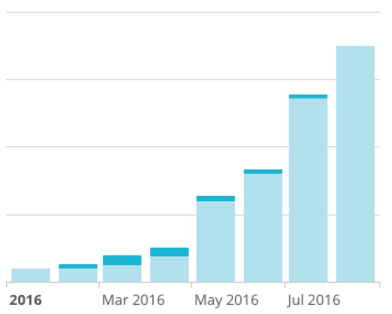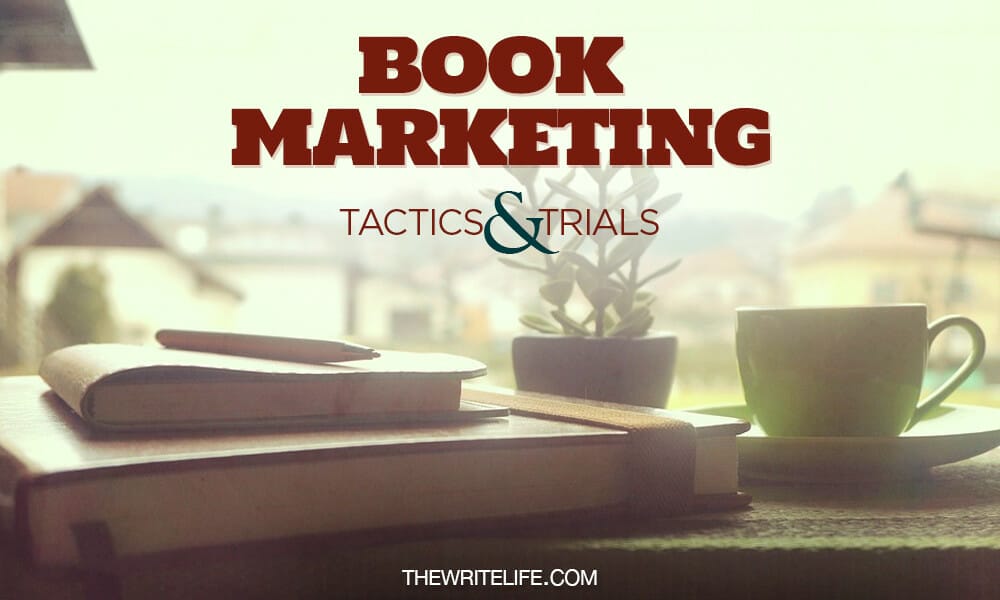If you’re an author who reads about book marketing, it’s already been hammered into your brain that your email list is your lifeline to long-term success.
Why? Because your email subscribers are your peeps.
They are the readers who love you so much they want to connect beyond the books themselves, and are the most likely to buy release after release as your body of works expands.
These are the people who make a true career as an author possible.
But how do you get a big email list? It’s a big mountain to scale when you’re starting at zero (which we all do!).
There’s not a one-size-fits-all answer to this, but there are some trends to help you develop your own email list. I’ve been experimenting with these tactics quite a bit.
And it’s been working. I entered 2016 with a measly 20 subscribers, but look at how my list has grown since:

My goal is to reach 1,000 subscribers by the end of the year. It’s going to be close, but I should be able to reach that number.
What have I been doing to get these month-to-month jumps? I’ve used a sales funnel that follows three basic steps.
It’s a lot like fishing — except for your readers, you’ll want to use an entirely different kind of bait.
Step 1: Cast your net
If you want to draw readers in, you must make an effort to reach out to them. This can take many forms, but the main idea is to make yourself visible to the right people in the right places, online.
What does this look like? Visibility can take the form of:
- Blogging frequently
- Posting on social media frequently
- Guest posting on blogs your target audience already reads
- Promoting yourself with ads on Facebook and other highly targeted, low-cost platforms
- Attending events and networking in person
- Hosting events to publicize your books
- Distributing promotional materials at conferences, book signings, etc.
Choose a few to start, and build as you’re able to throw more into the mix. The more you’re able to do (both in terms of frequency and diversity), the faster your list will grow.
Personally, I blog on my author website at least once a week, and post frequently to Twitter and Facebook. I try to guest post on a website with a shared audience at least once per month, plus I have about four ongoing columns that get published on various websites each month.
But my most effective tactic by far has been Facebook Ads, thanks to its ability to target so specifically and reach beyond my existing network.
I’m also working to participate in more events (and maybe host a few of my own). I’ve got at least one lined up every month from July to November, and I’m putting feelers out for 2017 events now.
Step 2: Bait the hook
People don’t sign up for email lists because they want more email. We all get way too many emails already.
The best way to grow your email list is to put a nice, juicy worm on your hook.
This is what we call magnet content: content that you give away for free in exchange for email addresses.
Some authors give away a full book to email subscribers, or even an entire box set. Others might offer a short story, or a character guide for an ongoing series. The important thing is to offer something your target readers will value.
Right now, I’m giving away the first chapter of my novel, but that’s a short-term fix. I wrote a novella specifically to give away to subscribers; I’m just waiting for the edits and cover design to come back.
An important note here: Don’t slack on your giveaway content just because it’s free! Give it the same professional treatment a publisher would give any other release. That means professional editing and design services.
It’s tempting to slack when you won’t make direct profit off this content, but this will be many writers’ first impression of you as an author. If it’s great, readers will be clamoring to buy your next book. If it’s meh (or worse, riddled with typos), readers aren’t going to want anything else from you.
I expect the switch to an exclusive freebie to boost my subscriber rate significantly. It’s also a proven tactic for increasing sales, so even though you may have to invest up front for editing and design, you’re almost certainly going to make up for it in sales later.
Step 3: Reel it in
When a person subscribes to your email list, it’s not the end of your campaign. In a way, it’s just the beginning.
Use the tools in your email management service to create an automated series designed to strengthen your connection with each new subscriber.
Brian Cohen recommends a five-part series, with each email a few days apart. Your series might look like this:
- Deliver the magnet content you promised and thank them for subscribing.
- Check in to follow up on the magnet content.
- Ask them to connect with you on social media, too.
- Give them a sneak peak at your next book.
- Invite them to join your street team.
I just learned about Cohen’s techniques a few weeks ago. What I have now is a three-part series:
- Delivers the free content.
- Asks new subscribers what they’re reading. I like this email because it asks readers about themselves, and lets us get to know each other better. (It’s also valuable to know what else my audience enjoys reading.)
- Offers an exclusive discount on the first book in my series.
Updating my automation series to incorporate Cohen’s insights is at the top of my author to-do list.
Bigger isn’t always better
Be careful you don’t get too hung up on watching your subscriber numbers grow.
A small but highly engaged list of people who can’t wait for your next email is better than a huge list of people who wonder “Who’s that?” as they skim over you in their inbox.
Instead of obsessing about how rapidly your list grows, pay close attention to who you target with your outreach; and mind your engagement stats (open rate, click-through) as much as your growth.
Authors, what do you do to grow your email list?







